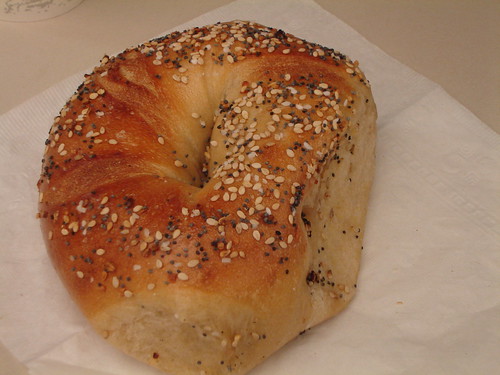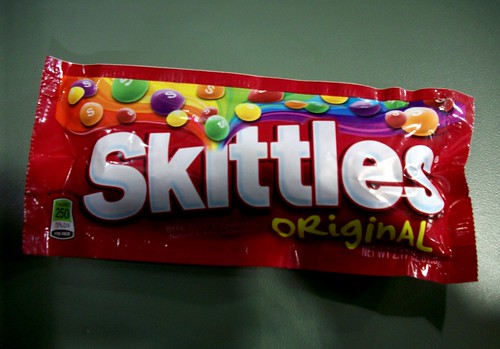(This essay is Part I of a series on carbohydrate addiction and the myth of ‘complex carbs’. You can skip to Part II, “Adjacent To This Complete Breakfast!” or Part III, “The Myth Of “Complex Carbohydrates”.)
Why do we crave the empty calories of bread? Answer: for the same reasons we crave the empty calories of candy.
Bread = Skittles
I’ve made the point before that bread—even whole wheat bread—is metabolically equivalent to Skittles, because it has the same glycemic index. You get the same sugar rush from a ‘healthy’ whole wheat bagel that you do from candy…and though it might not taste as sweet, it’s all the same to your digestive and metabolic system.

Whole-grain bagel: 280-350 calories, glycemic index 72.

Bag of Skittles: 250 calories, glycemic index 70.
(Calorie counts: bagel, Skittles. Glycemic index table here.)
A short layman’s explanation for those unfamiliar with food chemistry: “proteins” are just amino acids linked together in chains, and “carbohydrates” are just simple sugars (glucose, fructose, galactose) linked together in chains. When a carbohydrate is small (two simple sugars) and tastes sweet, we call it “sugar”—and when a carbohydrate is big (many simple sugars) and doesn’t taste sweet, we call it “starch”. But it’s all the same thing: “carbs” are just sugar, and your body breaks them all down into simple sugars before using them.
“Glycemic index” is a measure of how quickly the sugar in a food (including starch and other “carbohydrates”) appears in our bloodstream, fully disassembled, after we eat it. The higher the glycemic index, the quicker the sugar hit.
Note that white rice has a higher glycemic index (64) than Coca-Cola (58), and ‘healthy’ breakfast cereals like cornflakes (81) and Grape Nuts (71) have a higher glycemic index than a Snickers bar (55)! Read this list of 100 common foods: you’ll be surprised at which “healthy” foods are really just sugar bombs.
Interestingly, there is no special dietary name for short proteins: they’re all just called “protein”.
(A giant table of glycemic index for thousands of foods can be found here.)
Eating Like Cattle, Getting Fat Like Cattle
We are told to eat lots of ‘carbohydrates’ (sugars) in small meals throughout the day, as recommended by the nutrition industry (the ADA, most Western governments, and other wholly-owned subsidiaries of multinational agribusinesses and drug companies). In other words, we are told to graze—like cattle.
Grazing like a cow means that your bloodstream is always full of sugar. Glucose (a simple sugar) is our body’s primary energy source, and our bodies will always use it first if there is any available. We only start metabolizing fat for energy when there is no sugar left.
Unfortunately, by maintaining such a diet, our ability to metabolize body fat simply atrophies—because it’s never used! This is why dieters feel so desperately hungry, and why it’s hard to reduce ‘carbohydrate’ (= sugar) intake: we’ve got plenty of energy available in the form of body fat, but our body’s ability to metabolize it has atrophied—so we are metabolically starving in the midst of plenty. It’s like having a pantry full of canned tuna and discovering you’ve lost the can opener.
In the scientific literature, the ability to switch back and forth between glycolysis (burning sugar) and beta-oxidation (burning fat) is called “metabolic flexibility“. And while the above paragraph is simplified to avoid dragging my readers into the technical and biochemical details, the adventurous and inquisitive can learn more by viewing my 2013 Ancestral Health Symposium presentation “What Is Metabolic Flexibility, and Why Is It Important?” and the references in its bibliography.
This is the metabolic component of sugar (‘carbohydrate’) addiction.
(See this short cartoon for Tom Naughton’s entertaining layman’s guide to this metabolic catastrophe, which includes Type II diabetes in its end stages. I also recommend watching his full presentation “Big Fat Fiasco”, also available on DVD here.)
The Sugar Rush: Chasing Serotonin and Dopamine
There is a second component to sugar addiction: not only are sugars (‘carbohydrates’) metabolically addictive, they are most likely physically addictive too. Here’s how that works. (You can skip to the summary below if you’re not interested in the details.)
“Carbohydrates, when digested by the body, are effectively broken down into sugar molecules. When these molecules are absorbed and released in the bloodstream, blood concentration of glucose increases. Almost immediately, there will be a significant increase in plasma insulin levels as a result of the pancreas releasing its stored insulin. Insulin then steps in to do what it is genetically programmed to do–it breaks it down some more to produce energy and transport the extra glucose from the blood to the body cells. Insulin also makes it easy for tryptophan to enter the brain by eliminating its other amino acid competitors.”
[…]
“The concentration of the majority of the amino acids, including alanine and glutamine, are significantly reduced each time insulin is secreted. Tryptophan is then able to enter the brain at a higher rate. An increased level of tryptophan in the brain means more available tryptophan for conversion. Tryptophan undergoes hydroxylation to the 5 positions and is converted in 5-HT and eventually to serotonin.” –“Why Carbohydrates Instantly Increase Serotonin Levels”
The science behind this explanation:
PM Lyons and AS Truswell. Serotonin precursor influenced by type of carbohydrate meal in healthy adults. American Journal of Clinical Nutrition, Vol 47, 433-439
In summary: sugar (carbohydrates) boosts brain tryptophan levels, which makes us sleepy. This tryptophan boost increases brain serotonin levels over time, which makes us feel content and satiated (“food coma”). Furthermore, the immediate reward of eating palatable food is a dopamine rush: the same neurotransmitter behind drug highs like cocaine and amphetamine.
(In case you’re not familiar with serotonin: you’ll note that the common antidepressants (Prozac, Zoloft, etc.) are all SSRIs—selective serotonin reuptake inhibitors—which boost serotonin by blocking the body’s ability to reabsorb it.)
The problem is that, like any other addictive drug, the positive effects of bread (and other high-sugar foods) diminish over time—while the addiction remains.
The Journal of Neuroscience, September 29, 2010, 30(39):13105-13109. Weight Gain Is Associated with Reduced Striatal Response to Palatable Food. Eric Stice, Sonja Yokum, Kenneth Blum, and Cara Bohon
“Results indicated that women who gained weight over a 6 month period showed a reduction in striatal response to palatable food consumption relative to weight-stable women. Collectively, results suggest that low sensitivity of reward circuitry increases risk for overeating and that this overeating may further attenuate responsivity of reward circuitry in a feedforward process.”
Rephrased in simple language: the fatter you get, the less of a good feeling you get from eating tasty foods. (And here’s some rat science on striatal dopamine receptors, for those curious about the mechanisms.)
So we eat more and more ‘carbs’ (sugar) in an effort to recreate that dopamine rush and subsequent serotonin contentment…but as we gain weight, we get less and less of that reward. All we get is the sugar spike and subsequent metabolic crash.
Interestingly, alcohol apparently has a similar mechanism of addiction: it increases serotonin nerve activity, but depletes actual brain serotonin. See: Adv Exp Med Biol. 1999;467:265-74. Tryptophan metabolism in alcoholism. Badawy AA. And it is perhaps not a coincidence that women with a family history of alcoholism are more likely to be obese.
Further Reading (optional):
Carbohydrate craving: a double-blind, placebo-controlled test of the self-medication hypothesis. Corsica JA, Spring BJ. Eat Behav. 2008 Dec;9(4):447-54.
Psychobiological effects of carbohydrates. Spring B, Chiodo J, Harden M, Bourgeois MJ, Mason JD, Lutherer L. J Clin Psychiatry 1989 May;50 Suppl:27-33
The effect of carbohydrates on affect. Larry Christensen, PhD. Nutrition Volume 13, Issue 6, Pages 503-514 (June 1997)
“…Carbohydrate consumption is relevant for individuals experiencing symptoms of emotional distress, particularly symptoms indicative of depression, and that the individuals with depressive symptoms show a preference for sweet simple carbohydrates.”
Summary
In summary, carbohydrates are addictive in two ways, both factually established:
- First, because they’re really just sugar, and we get the same sugar rush from bread that we get from candy.
- Second, because sugar pumps up dopamine and serotonin levels in the short-term—but, like any addictive drug, the reward diminishes over time, while the compulsion to eat ‘carbohydrates’ (sugar) remains.
Breaking Our Bread Addiction
So how do we break our bread addiction?
There is good news! My experience, and that of most people attempting a paleo diet (which is ‘low-carb’, or low-sugar, by definition, unless you’re making a concerted effort to eat potatoes), is that you can indeed regain your ability to burn body fat for energy—and once you’re ingesting enough protein and B vitamins, your serotonin levels won’t be completely dependent on eating sugar. (Eat more meat and eggs.) The relentless sugar cravings slowly dissipate over a couple weeks.
You’ll find that not only do you not crave huge piles of empty sugar calories (bread, pasta, potatoes) with meals—as a bonus, you’ll find that it’s suddenly much easier to go without food entirely, because your body is learning how to burn fat again! You’ll be able to skip a meal without feeling like you’re going to die of hunger…and you’ll also discover that being a little bit hungry substantially boosts your mental capacities due to the action of ghrelin, once you’re no longer distracted by hunger pangs.
Though I can’t find any human studies (since it’s difficult to measure brain tryptophan and serotonin levels without dissecting the brain), there is suggestive evidence from animal studies that fasting raises brain serotonin:
Changes in brain serotonin metabolism associated with fasting and satiation in rats. J. Pérez-Cruet, A. Tagliamonte, P. Tagliamonte and G. L. Gessa. Life Sciences Volume 11, Issue 1, Part 2, 8 January 1972, Pages 31-39
“The synthesis rate of brain serotonin was about 30% lower in rats fed for two hours than in rats fasted for 24 hours.”
Also see Br J Pharmacol. 1984 October; 83(2): 357–362. The effect of fasting on 5-hydroxytryptamine metabolism in brain regions of the albino rat. L. D. Fuenmayor and S. García. [Note: 5-hydroxytryptamine = serotonin.]
There are still unanswered questions here: how long do we have to go between meals to produce a rise in serotonin? (It might happen after an hour, three hours, or twenty hours.) Is abstaining from sugars (‘carbs’) sufficient, or must one fast altogether? More research is needed here: if you know of any that I’ve missed, please leave a comment.
My non-scientific advice is: don’t try to go cold turkey, but do make a strong effort to replace sugars (‘carbs’) with real food whenever you can. Cook bacon and eggs for breakfast, grab hard-boiled eggs or dinner leftovers if you’re on the go, and if you must have that piece of buttered toast, go for it—because it’s still infinitely more satisfying and nutritious than a breakfast of cold cereal or a bagel. It’s better to be happy and calm than a stressed-out diet purist. But as you slowly reduce your sugar intake, you’ll find that you miss candy (and its metabolic equivalent, bread) less and less…
…and you’ll enjoy life more and more without your sugar (‘carbohydrate’) addiction.
Live in freedom, live in beauty.
JS
(This essay is Part I of a series on carbohydrate addiction and the myth of ‘complex carbs’. Continue reading Part II, “Adjacent To This Complete Breakfast!”)
Postscript: Paleo Is Not Atkins, Nor Is It Zero-Carb
The paleo diet is not Atkins, nor is it zero-carb. The best research I can find shows that modern hunter-gatherers get perhaps 1/3 of their calories from carbohydrate, and Paleolithic hunter-gatherers somewhat less. This means vegetables, including root starches like sweet potatoes: grains were not a meaningful part of the human diet until agriculture, of which the earliest evidence is only 12,000 years ago. (This is a tautology: agriculture defines the transition from Paleolithic to Neolithic.)
“In this review we have analyzed the 13 known quantitative dietary studies of hunter-gatherers and demonstrate that animal food actually provided the dominant (65%) energy source, while gathered plant foods comprised the remainder (35%).” Eur J Clin Nutr. 2002 Mar;56 Suppl 1:S42-52. The paradoxical nature of hunter-gatherer diets: meat-based, yet non-atherogenic. Cordain L, Eaton SB, Miller JB, Mann N, Hill K.
(Did you enjoy this article? Use the icons below to spread it! Then, continue reading Part II.)






